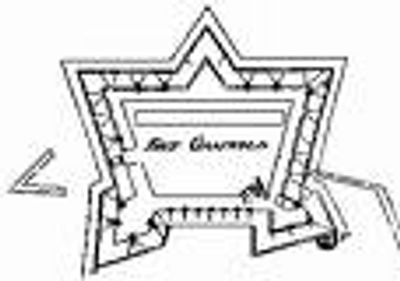Forts Trumbull & Griswold - The Defense of The Thames River

Defensive Positions
Fort Griswold, named after Governor Matthew Griswold of Lyme, stood as the primary defense for the Thames River. This impressive fort, built in the European star fort style, featured "V" shaped earthworks strategically designed to shield its gates from cannon fire. Barracks accommodated up to 300 men. With its nearly 9-foot-tall stone and earth walls, Fort Griswold presented a formidable obstacle to potential raiders approaching upriver. A redoubt to the east and a covered passage leading to the southern munitions stores further enhanced its defenses. Its cannons commanded the Long Island Sound, and its elevated position provided a significant advantage against land attacks from the river. However, despite its recent construction, the fort was already showing signs of disrepair by 1776, as noted by its garrison. Following inspections by Colonel William Ledyard, Captain Shapley, and Coit of New London, funds were secured for partial repairs.
To further bolster Groton Bank's defenses, a network of Sea Coast Guard posts stretched from Noank and Portersville (Mystic) to Gales Ferry. These posts, manned by 5-20 men, served as early warning systems and aimed to curtail smuggling to and from Long Island, a Tory stronghold. Additional posts were located at Waterford (modern Waterford Beach), Black Point in Niantic (East Lyme), and intermittently at Giant's Neck and Old Lyme.
On the New London side, Fort Trumbull, named for the Connecticut governor, faced the waterfront but was vulnerable to land attacks from the west. Fort Folly (or Nonsense), a simple earthen work with a cannon, stood midway between Fort Trumbull and downtown New London. A small battery with a cannon defended the foot of Main Street (State Street). Winthrop Cove, near the modern Gold Star Bridge, was protected by another defensive position, safeguarding the vital wharf and shipyard owned by Guy Richards.
ALARMS: A signal system alerted local militia and townspeople to enemy activity. Two consecutive cannon blasts signaled an enemy landing or approach, while a third blast indicated the capture of a "prize." Although approximately 25 alarms were sounded during the war, most enemy actions were limited to probing efforts, primarily "foraging" expeditions to seize cattle and supplies.
THE HARBOR: "DEN OF SERPENTS" Sir Henry Clinton, commander of British forces in America, famously dubbed the Thames River area "The Den of Serpents." New London's privateers, operating with remarkable success, captured hundreds of British prizes, frustrating the Royal Navy and Army's attempts to suppress them.
Alarms -Signals - A Prize Taken, Call to Arms
A series of signals were established to notify the countryside of:
2 Consecutive Shots by Cannon -Alarm for Help - Call to Arms
3 Consecutive Shots by Cannon -A prize has been taken (Privateer) & has arrived in New London
In addition each of the guard posts would use fires to signal the call to arms.
This website uses cookies.
We use cookies to analyze website traffic and optimize your website experience. By accepting our use of cookies, your data will be aggregated with all other user data.